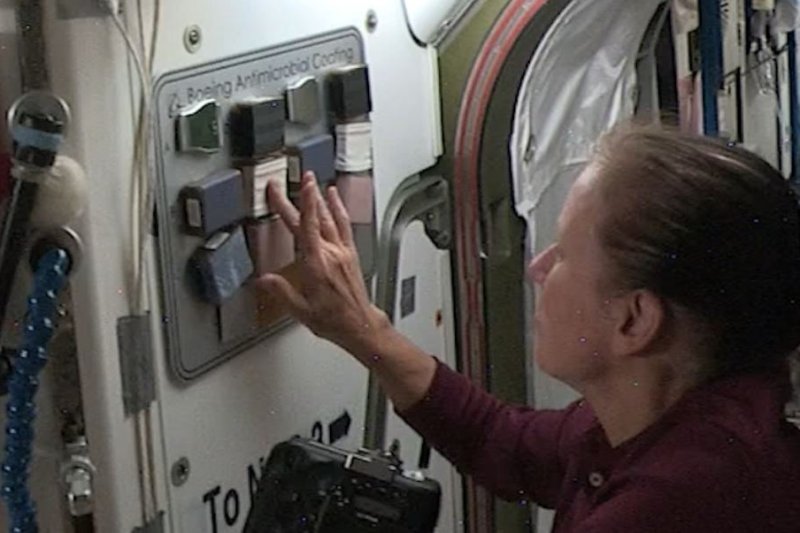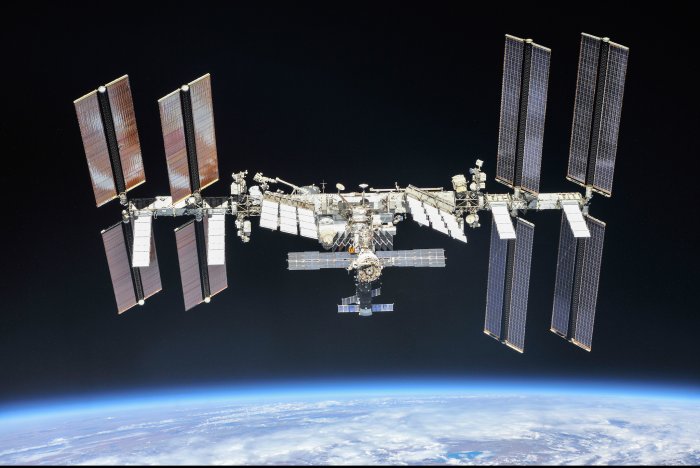1 of 3 | NASA astronaut Shannon Walker touches antimicrobial surface coatings on various surfaces as part of a test for Boeing aboard the International Space Station. Photo courtesy of NASA
ORLANDO, Fla., March 19 (UPI) -- Astronauts on the International Space Station are testing surface coatings intended to kill viruses and germs, including the coronavirus that causes COVID-19.
The test for The Boeing Co. has astronaut Shannon Walker touch a dozen coated items daily -- like seatbelt buckles and plastic and cloth samples -- to transfer microbes commonly found on humans to them.
After six months in space, the items will return to Earth in early May, where researchers will determine how the microbes fared on the treated surfaces.
NASA already has determined from previous experiments that microbes, especially bacteria, grow more readily in the microgravity of orbit.
Boeing hasn't revealed exactly what the surface coating is, but a spokesman confirmed that it is a polymer substance sprayed onto the items.
That is similar to a product used in some commercial aircraft, which is called SurfaceWise2. It's made by Dallas-based Allied BioScience, which received an emergency use authorization from the U.S. Environmental Protection Agency to battle the coronavirus.
Excessive amounts of microbes in food or water aboard the space station could create health risks, said Liz Warren, senior program director for the International Space Station U.S. National Laboratory, which manages all science aboard the orbiting platform.
"If you can, for example, understand what makes microbes more virulent in microgravity. that may help you design new antibiotics or other tools to combat microbes for us here on Earth."
The National Laboratory found the experimental substance was safe for use in the space station, Warren said.
Boeing tests the substance for use in aircraft and spacecraft, said Mike Delaney, Boeing's chief aerospace safety officer. The company is the primary contractor for the space station, so it may want to deploy the antimicrobial coating on surfaces there in the future, he said.
"While testing continues on orbit and on Earth, we're encouraged by the preliminary results of the antimicrobial chemical compound," Delaney said in an email.
Much of the work on such antimicrobials has been led in the United States by Charles Gerba, professor of microbiology and leading anti-microbial researcher with the University of Arizona.
"SurfaceWise2 creates an invisible barrier on surfaces, which physically breaks down and kills virus cells," Gerba said in an email, adding that the Boeing substance acts in the same manner.
The goal is to coat high-touch areas, such as seats, armrests, tray tables and overhead bin doors, he said.
"We have published work showing hospital-acquired infections can be reduced by 36% by antibacterial coatings that last up to 90 days," Gerba said.
Walker and three other astronauts are scheduled to return home with the samples in sealed containers during the second week of May in a SpaceX Crew Dragon capsule.
The International Space Station is photographed by Expedition 56 crew members from a Soyuz spacecraft after undocking on October 4, 2018. NASA astronauts Andrew Feustel and Ricky Arnold and Roscosmos cosmonaut Oleg Artemyev executed a fly-around of the orbiting laboratory to take pictures of the space station before returning home after spending 197 days in space. Photo courtesy of NASA/Roscosmos
















